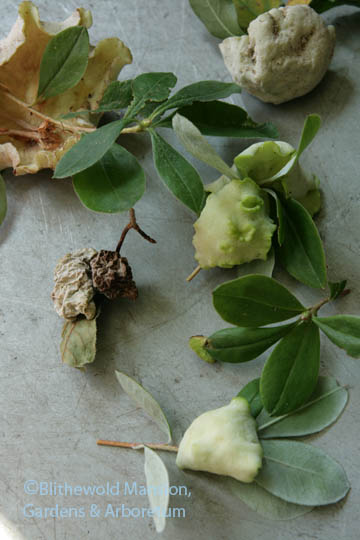Pinkster apples
 The other day friend of mine and Blithewold’s left a bag full of these delicious looking things on my desk with a note suggesting they might make a good blog post. Indeed. I’ve never seen them before and I never can resist finding out more about weird things whether they show up on my desk or not.
The other day friend of mine and Blithewold’s left a bag full of these delicious looking things on my desk with a note suggesting they might make a good blog post. Indeed. I’ve never seen them before and I never can resist finding out more about weird things whether they show up on my desk or not.
They are azalea leaf and flower galls caused by a fungus amongus named Exobasidium vaccinii. It’s a weather-related blight probably brought on by our warm winter and wet late-spring into summer, that turns infected leaf and flower tissue into fleshy aliens. It affects azaleas, rhododendrons and camellias but isn’t usually life-threatening. Just ugly. Treatment involves nothing more than cutting them off the shrubs as my friend did and burying them or burning them. (Leaving them on someone’s desk as a novelty is an optional middle step.) And it’s best to catch the galls before they turn dusty white with spores or into gray knobs that indicate they’ve done their business.
They are called Pinkster apples because the Pinkster (or Pinxter or Pink) azalea (Rhodendron periclymenoides) is particularly susceptible and galls on its flowers turn pinkish. And in case you thought I was kidding about them looking delicious, I was and wasn’t. Some sources (including my own pinkster apple source) say that they’re a delicacy. But I can’t find any recipes to try, only warnings about how rhodies, especially the leaves, are poisonous.
I took a quick walk around to check out Blithewold’s rhododendrons and azaleas and didn’t spot any signs but judging by the contents of the bag, it may be a problem this year for other gardeners. Have you ever spotted anything like this on your azaleas? (Do you have a recipe for them?)
